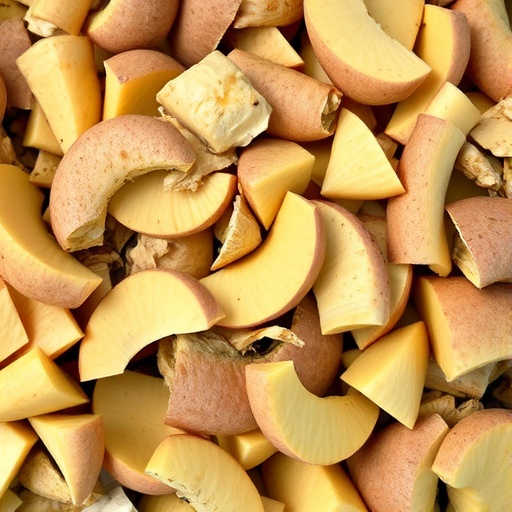In a groundbreaking study published in Waste Biomass Valor, researchers V. Filiberti, A.B. Andreu, and M.X. Silveyra explore the potential health benefits of an often-overlooked food byproduct: potato peel waste. This innovative research highlights the neuroprotective properties of polyphenols derived from potato peels, shedding light on their antioxidant effects and mitochondrial functionalities in neuronal cells. As the world grapples with an increasing prevalence of neurodegenerative disorders, the findings of this study bring forth the exciting prospect of turning waste into a valuable resource for health interventions.
The emphasis on potato peel waste is particularly timely. With the global food industry generating massive amounts of waste, the valorization of such byproducts is of paramount importance. Potato peels, often discarded as mere trash, are being re-examined for their rich nutrient profile, most notably their high concentration of polyphenols. These compounds are known for their strong antioxidant properties, crucial in combating oxidative stress—an imbalance that can lead to cellular damage and various health issues including neurodegenerative diseases.
In their experimental setup, the researchers utilized HT-22 neuronal cells to evaluate the effects of potato peel-derived polyphenols. These neuronal cells, frequently used as a model for examining neuroprotective properties, allowed researchers to investigate the potential pathways through which the polyphenols exert beneficial effects. The study meticulously detailed how exposure to these compounds resulted in significant reductions in oxidative stress markers, suggesting a protective effect on neuronal health.
The mitochondrial functions of the cells were another focal point of the study. Mitochondria are often dubbed the powerhouses of the cell, playing essential roles in energy production and metabolism. The research findings indicated that potato peel polyphenols not only reduced oxidative stress but also enhanced mitochondrial function. This dual action positions these natural compounds as potential candidates for therapeutic interventions aimed at improving neuronal resilience against metabolic dysfunctions commonly observed in neurodegenerative disorders such as Alzheimer’s and Parkinson’s diseases.
Furthermore, the antioxidant capacity of the polyphenols was quantified using various assays which demonstrated their potency. The results were remarkable: potato peel extracts exhibited a considerable ability to scavenge free radicals, thereby neutralizing harmful species that could otherwise lead to cellular damage. This challenges the traditional view of waste and highlights the importance of rethinking our disposal strategies towards food byproducts, particularly in relation to their possible health applications.
In the face of mounting evidence supporting the health benefits of polyphenols, the study’s authors advocate for an increased focus on dietary patterns that include these compounds. They suggest that incorporating foods rich in antioxidants into daily diets can serve as a preventive measure against neurodegenerative diseases. This comprehensive approach not only champions better health outcomes but also promotes sustainability by encouraging the use of food waste as a resource.
The implications of this research extend beyond just neuroprotection. The global food system is currently facing significant challenges in sustainability and waste management. By promoting the use of potato peel waste, there is potential for significant improvements in environmental impact as well. The process of waste valorization not only addresses the ongoing issues of food waste but also creates opportunities for new avenues in health and wellness.
Importantly, policy makers and public health officials are encouraged to integrate this knowledge into local and global health strategies. By endorsing dietary practices that utilize food byproducts, there could be a wider acceptance and implementation of waste-to-nutrient transitions in food systems. This alignment could play a pivotal role in the development of new health policies focused on both environmental sustainability and public health improvement.
The economic aspects of this research cannot be overlooked either. Valorizing potato peel waste opens up new markets and job opportunities. As industries look to minimize waste while maximizing value, there may be incentives for businesses to invest in technologies that extract beneficial compounds from agricultural byproducts. This not only aids in waste reduction but also supports the economy by fostering innovation within the food processing sector.
As the research landscape shifts toward holistic and integrative approaches, the findings from Filiberti and his colleagues spotlight the interconnectedness of health, nutrition, and environmental stewardship. By changing perceptions about food waste, we can cultivate a culture that values all parts of our food systems—fostering both human health and environmental sustainability.
Furthermore, the exploration of potato peel-derived polyphenols could serve as a springboard for future studies aimed at uncovering other food waste streams that harbor beneficial properties. The potential for edible waste conversion into health-promoting substances could revolutionize current practices in food technology and nutrition. It invites scientists, nutritionists, and entrepreneurs alike to rethink the definition of what constitutes food and nutrition.
Finally, this research underscores a critical shift in how we perceive waste and health. As more studies emerge illustrating the benefits of various food-derived compounds, the barriers between waste and nutrition will continue to dissolve, paving the way for innovative solutions that address both human health and environmental challenges. Together, society can embrace a pathway towards a more sustainable future, one that proudly integrates nature’s gifts into our daily lives, turning yesterday’s waste into tomorrow’s health solutions.
Subject of Research: Valorization of Potato Peel Waste as a Source of Neuroprotective Polyphenols
Article Title: Valorization of Potato Peel Waste as a Source of Neuroprotective Polyphenols: Antioxidant and Mitochondrial Effects in HT-22 Neuronal Cells
Article References:
Filiberti, V., Andreu, A.B. & Silveyra, M.X. Valorization of Potato Peel Waste as a Source of Neuroprotective Polyphenols: Antioxidant and Mitochondrial Effects in HT-22 Neuronal Cells.
Waste Biomass Valor (2025). https://doi.org/10.1007/s12649-025-03390-1
Image Credits: AI Generated
DOI: https://doi.org/10.1007/s12649-025-03390-1
Keywords: Potato peel waste, polyphenols, neuroprotection, antioxidants, mitochondrial function, HT-22 cells, food valorization, neurodegenerative diseases, environmental sustainability.




